Reserve Bank of Australia Annual Report – 1999 Customer Services
The Reserve Bank provides banking facilities for governments, and registry services for the Commonwealth and some State government and overseas agencies; electronic settlement services for securities transactions and payments through the Reserve Bank Information and Transfer System (RITS); and a bulk currency note issue facility.
Some of the services provided by the Bank are contestable in that they can also be provided by private sector organisations, while others such as note issue and interbank settlement facilities are core, non-contestable, central bank functions. To facilitate transparency and accountability, contestable activities are set up on a business-unit basis with each unit operating in accordance with the competitive neutrality guidelines established under the Government's competition policy. Separate accounts are prepared for each business unit reflecting full costs, revenues, taxation and notional capital attributable to the business (these are detailed in the Appendix to this chapter). In 1998/99, pre-tax profits from contestable activities were $6.6 million. Revenues from contestable activities were $30.2 million, compared with costs of $23.6 million.
Activity in the banking business continued to follow the trend towards greater use of electronic facilities. Substantial resources were committed during the year to the establishment of direct banking relationships with individual Commonwealth Government departments and agencies in preparation for their acceptance of responsibility for their own banking arrangements on 1 July 1999. Following the loss of the Tasmanian Government banking business, the Hobart branch was closed on 30 October 1998. Two other government customers, Western Australia and Australian Capital Territory, have recently selected other banks to conduct their banking business.
1998/99 was the first full year of operation of the Bank's real-time gross settlement (RTGS) system for interbank payments. The performance of the system exceeded expectations and has positioned Australia at the forefront of countries in providing an efficient, robust platform for minimising interbank settlement risk.
During the year, work also continued on the reorganisation of the bulk cash distribution arrangements. This was done with a view to reducing the volume of currency note processing undertaken by the Bank, reflecting the benefits of increased durability and lower counterfeit experience of polymer notes.
Banking
During the year, the Reserve Bank continued its program of implementing operational improvements to enhance the quality of its banking services and to strengthen the profitability of the business. Outsourcing of the Bank's cheque-processing operations to the Commonwealth Bank was completed with the transfer of the remaining part of the activity, the data capture of cheques drawn on other financial institutions deposited by Reserve Bank customers.
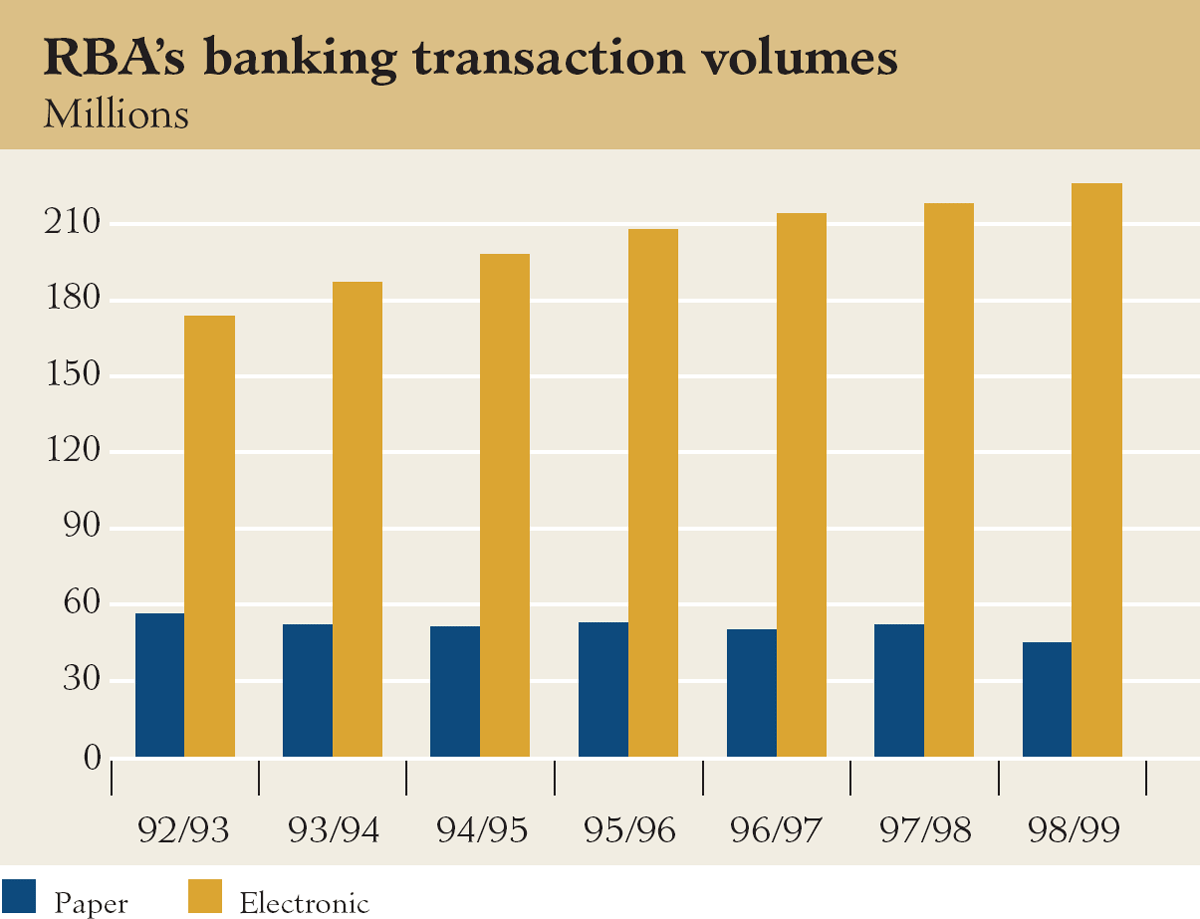
The Bank also participated in the industry-wide implementation of electronic exchanges of presented and dishonoured cheque data. This project has enabled the banking industry to shorten the cheque-clearing cycle and allow customers earlier access to funds. While the Reserve Bank always has allowed its government customers same-day access to deposited funds, the move to electronic presentment and dishonour has streamlined the cheque-clearing process and, together with the outsourcing of cheque-processing, has enabled costs to be held down at a time of continuing decline in paper volumes. Paper transactions declined by 15 per cent to 45 million items in 1998/99, from 53 million items in 1997/98.
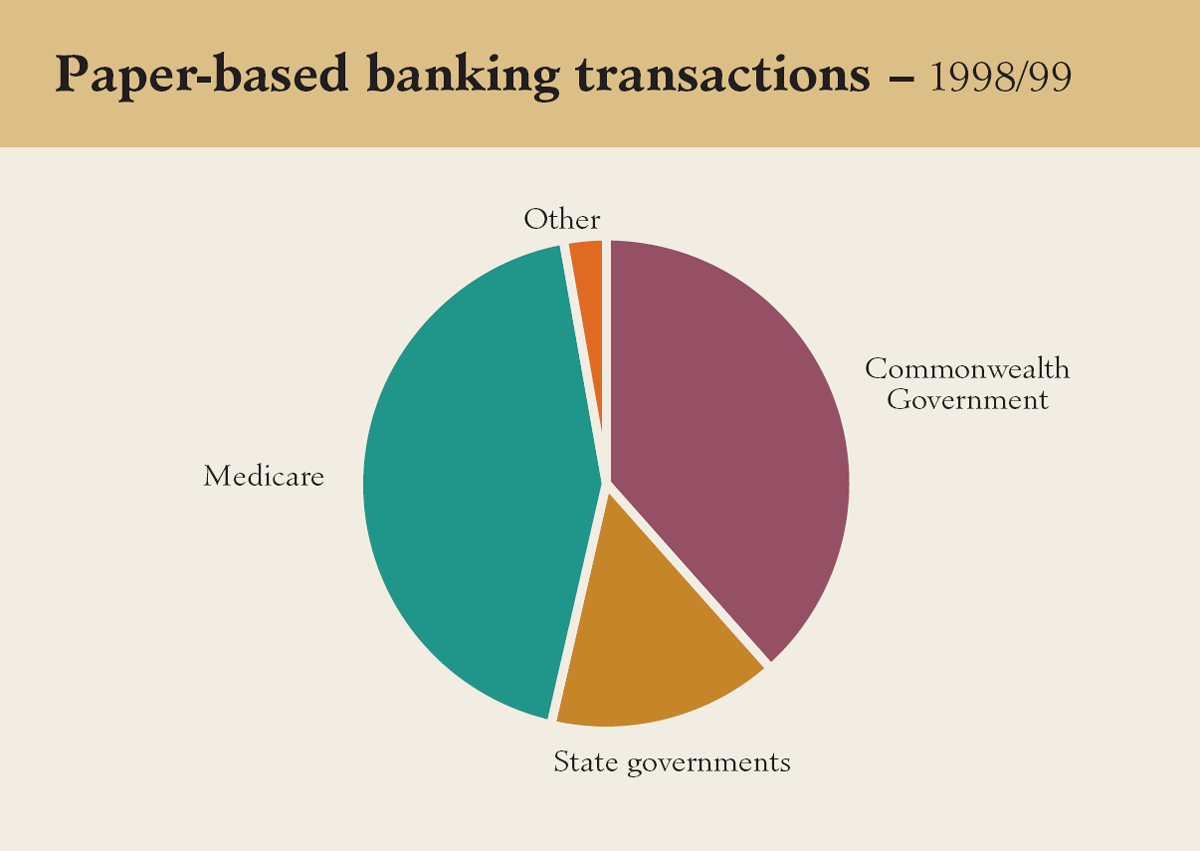
On the other hand, electronic transactions through the Government Direct Entry System (GDES) (which receives payments data from various customers and subsequently sorts and electronically distributes them to a wide range of financial institutions) increased in 1998/99 by around 3.7 per cent to 226 million items. This increase was partly the result of the Health Insurance Commission's efforts to gain increased acceptance of electronic crediting of Medicare rebates instead of cash and cheque-based payments: around one million payments were switched to direct entry during the year. During 1998/99 the Federal Reserve Bank of New York, on behalf of the US Government, commenced using GDES to distribute pension payments to United States pensioners resident in Australia.
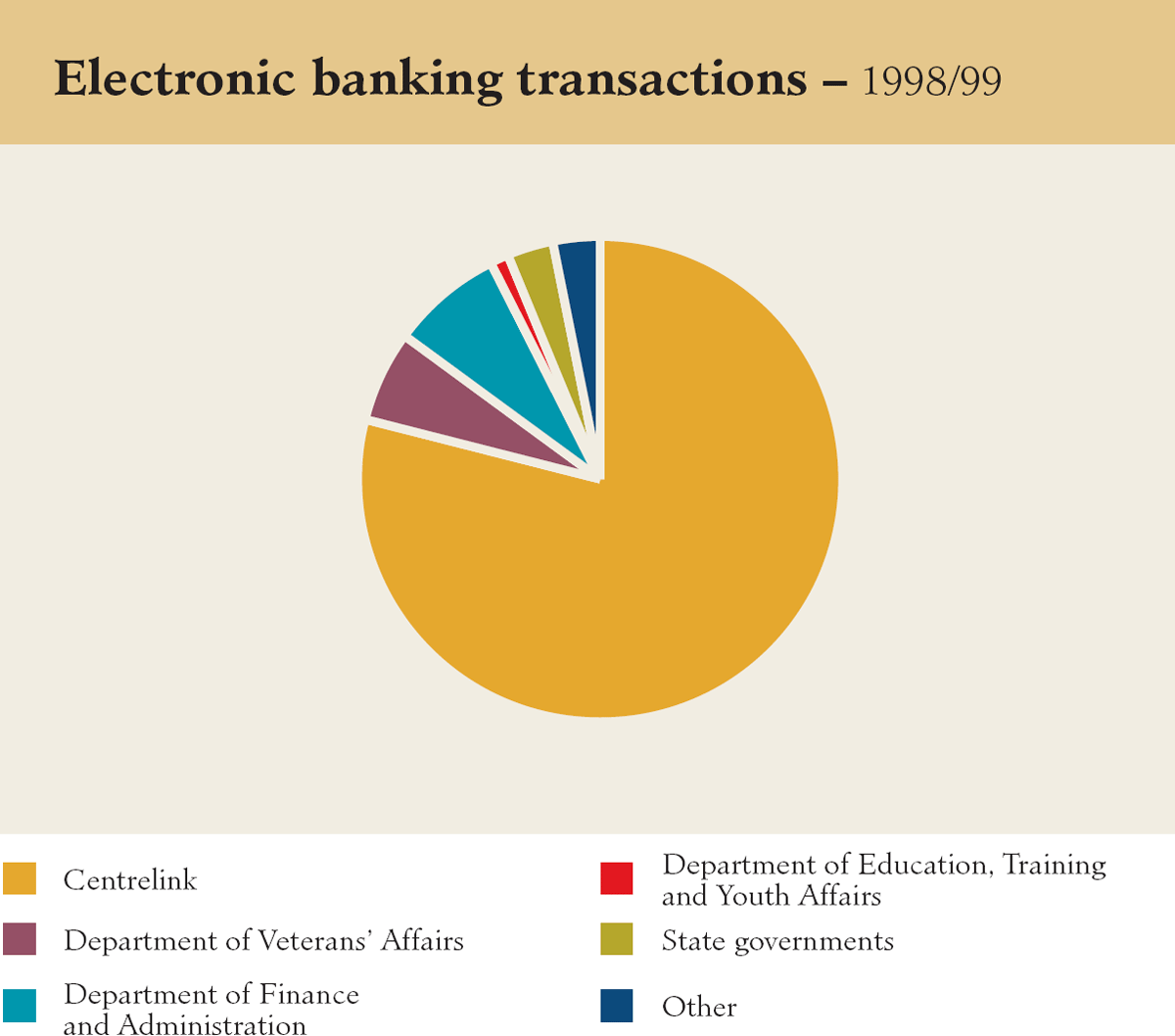
Devolution and market testing
During 1998/99, the banking business was restructured in preparation for the devolution of the Commonwealth's banking business on 1 July 1999. From that date, all Commonwealth departments and agencies became responsible for their own individual banking arrangements. Prior to devolution, the Bank had direct links with only five government departments and statutory authorities – the departments of Veterans' Affairs, Attorney-General and Finance and Administration, and Centrelink and the Australian Taxation Office. The Department of Finance and Administration (DoFA), in turn, handled overall government banking facilities for a further 75 government departments and agencies. In preparation for the post 1 July arrangements, direct banking links were established with each of the 75 separate government departments and agencies.
The competitive neutrality and devolved banking arrangements necessitated the separation of the Reserve Bank's banking business into two parts – the core account-keeping function and the contestable transaction-processing business. The Commonwealth Public Account, now known as the Official Public Account (OPA), has remained with the Reserve Bank as it is important for the implementation of monetary policy and for the smooth operation of the RTGS system. The Commonwealth's foreign exchange requirements also continue to be provided by the Bank. The new arrangements do not preclude the processing of government transactions by other banks so long as net balances end up in the OPA at the Reserve Bank at the end of each day. A new system has been developed to sweep Commonwealth department and agency balances from their transactional bankers to the OPA each night. The Bank's desktop banking package, Reservelink, was also upgraded to facilitate the new agency banking arrangements. In addition to its core account-keeping function, the Bank also provides a range of financial reports and interest payment facilities to assist DoFA in the management of the new agency banking arrangements.
Under the new devolved banking arrangements, government departments and agencies are, within a reasonable time, required to test the services provided by the Reserve Bank against what is available from other service-providers. This process has already commenced and DoFA moved its departmental banking business to another service provider on 1 July. It is anticipated that the full working-out of the new arrangements will be a gradual process extending over at least twelve months.
Registry and Security Settlement Services
The Reserve Bank provides registry services for the Commonwealth Government and other domestic and foreign official organisations. Services are provided through the Bank's branches and include the issue, transfer and registration of securities, maintenance of ownership records, periodical payment of interest and the redemption of securities at maturity.
As with previous years, activity levels in the registry area continued to decline as a result of growth in electronic settlements. Activity was also significantly affected in 1998/99 by the loss of the Western Australian Treasury Corporation business. In this contracting environment, the Bank has kept the business under continuous review to ensure that services are delivered in a cost-effective manner, whilst retaining a focus on quality of service. As a result of this process, improved operational efficiencies have allowed reductions in the cost of registry services to be passed on to the Bank's larger clients during 1998/99.
RITS provides its 143 members (representing 260 organisations) with facilities for the electronic settlement of transactions in Commonwealth Government securities (CGS). RITS handles 98 per cent of CGS turnover in the market and has securities with a face value of $80 billion (92 per cent of total CGS on issue) lodged in it.
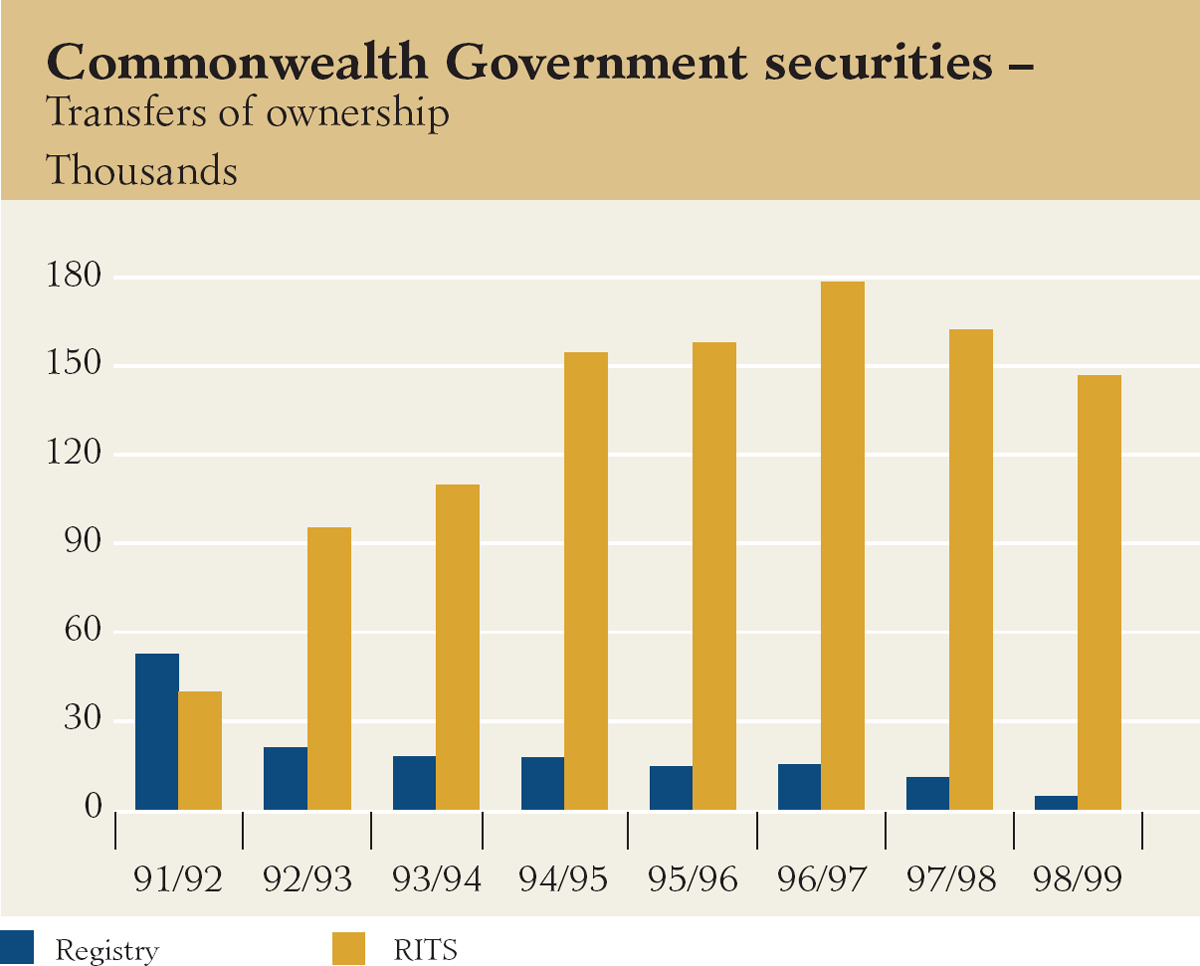
The system also provides facilities for electronic tendering for CGS, automatic interest and maturity payments for securities lodged in the system and for settling the interbank component of equity transactions on CHESS, the Australian Stock Exchange's electronic settlement system.
RITS is also the system through which banks access their Exchange Settlement (ES) accounts with the Bank. It was substantially enhanced in 1997/98 to be the platform for Australia's RTGS system, which commenced operation on 22 June 1998.
RTGS system
The Reserve Bank's RTGS system for interbank payments is one of the most advanced and comprehensive in the world. About 90 per cent of the total values exchanged between Australian banks is settled across RITS on an RTGS basis and hence is not subject to domestic interbank settlement risk. RTGS payments include securities markets settlements, the Australian dollar leg of foreign exchange transactions and payments, including time-critical ones, on behalf of corporate customers. The system has now been in full operation for over twelve months and its performance has exceeded expectations.
| Value ($ billion) | Number (thousands) | Average payment size ($ million) |
|
|---|---|---|---|
| Commonwealth Government securities | 14 | 1 | 18 |
| Other securities | 22 | 3 | 8 |
| Foreign exchange transactions and customer payments | 67 | 13 | 5 |
| Total (excluding intraday repurchase agreements with the Bank) | 103 | 17 | 6 |
For most of 1998/99, the average daily value of RTGS transactions fluctuated at around $100 billion, with significantly higher values recorded in June, reflecting the relatively high activity in markets in the last month of the financial year.
Average daily RTGS transaction numbers rose from around 15,000 in the September quarter of 1998 to nearly 17,000 in the June quarter of 1999. This largely reflects an increase in the number, but not value, of foreign exchange transactions and customer payments; the average size of these transactions fell from $6.0 million to $4.9 million over the same period. On busy days, activity increases substantially: on the peak day in 1998/99, 25,000 transactions with a value of $160 billion were settled.
The RTGS system has proved to be very efficient in its operation and, importantly, is economical in its liquidity requirements. An indication of this is given by the size of the queue at its peak compared with total payments settled. On average, the peak number and value of queued transactions represent only about 10 per cent of total payments settled each day.
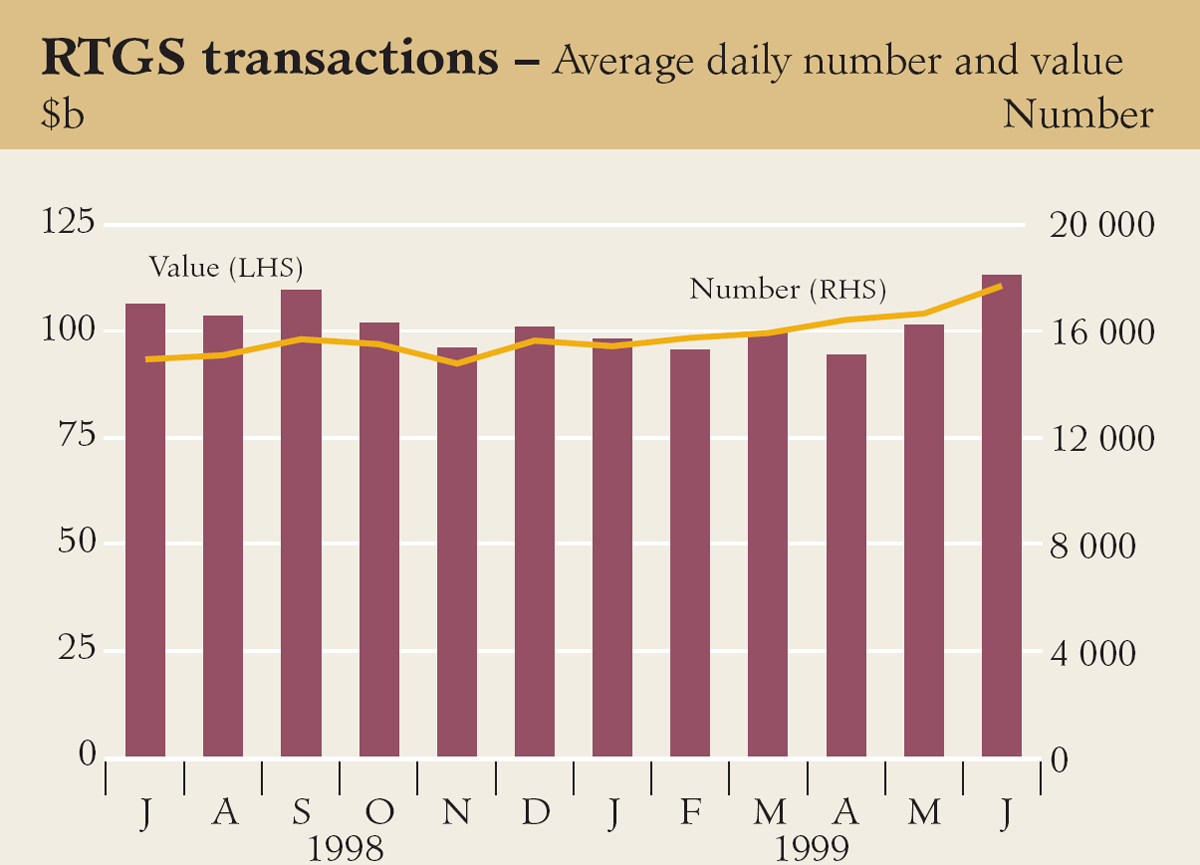
To supplement banks' holdings of cash in their ES accounts, inexpensive intraday liquidity is provided by the Reserve Bank by means of repurchase agreements in eligible Commonwealth and State Government securities. On an average day, 15 to 20 banks use this facility, with $4 to $5 billion of intraday liquidity provided.
Total daily liquidity sourced from intraday repurchase agreements and ES account balances currently averages around $6 billion, equivalent to about 6 per cent of the total daily value of RTGS transactions. As banks gained more experience with the settlement of transactions on an RTGS basis, and with the ready availability of intraday liquidity, over the year banks reduced the amount they held in the form of ES account balances (this is discussed in detail in ‘Operations in Financial Markets’).
The Bank strives to ensure that the operation and performance of the RTGS system matches world best practice and that the system is responsive to the needs of the industry. Contingency arrangements involving recourse to back-up systems are tested regularly. Performance upgrades have recently been introduced to ensure system throughput and capacity comfortably exceed current and expected future peak load requirements. Several enhancements to the system have already been made and others are planned after the Year 2000 moratorium. Two of the more important prospective changes are linkages with the Australian Stock Exchange to permit optional RTGS settlement of high-value equity transactions and inclusion of the Australian dollar in the Continuous Linked Settlement Bank initiative to reduce settlement risk in foreign exchange transactions.
Settlement services are also provided for the Bank's own transactions in the domestic securities and foreign exchange markets, as well as for those arising from business transacted by official customers domestically and abroad. The Bank also acts as collator of banks' obligations arising from the low-value clearing streams (paper, and bulk and retail electronic) managed by the Australian Payments Clearing Association.
Note Issue
The note issue functions of the Bank involve the bulk issue of notes; the processing of notes returned from circulation for fitness and authentication; and research into and development of note designs and security features.
The move to polymer-based currency notes has had an effect on all areas of the Bank's note issue activities. Polymer notes have been in circulation in Australia for over seven years. It is now three years since the final note in the current series of polymer notes was issued and, for practical purposes, all Australian currency notes in active circulation are now polymer. Primarily, the move to polymer substrate was based on the need for enhanced bank note security. Our experience has confirmed that, not only are the polymer notes more difficult to counterfeit, they are more durable and can be more efficiently processed by a range of different types of machines.
Note processing and distribution
The community's demand for currency continues to grow broadly in line with the economy despite the rise in electronic payments facilities such as EFTPOS and direct entry. The value of notes on issue in 1998/99 rose by 8.8 per cent, a higher rate of increase than last year. Demand for $50 and $100 notes continued to grow strongly. About 88 per cent of the value of notes on issue is accounted for by these two denominations. During the year, the Reserve Bank issued into circulation around $79 billion in currency notes and had $77 billion in notes returned. Around one billion notes (with a value of around $40 billion) returned from circulation were processed through the Bank's high-speed note-processing machines compared to 1.4 billion last year (with a value of around $52 billion). About 94 per cent of these notes were classified as fit for reissue. The high rate of reissue, which has grown over recent years, reflects durability and cleanliness of polymer notes compared with paper-based notes.
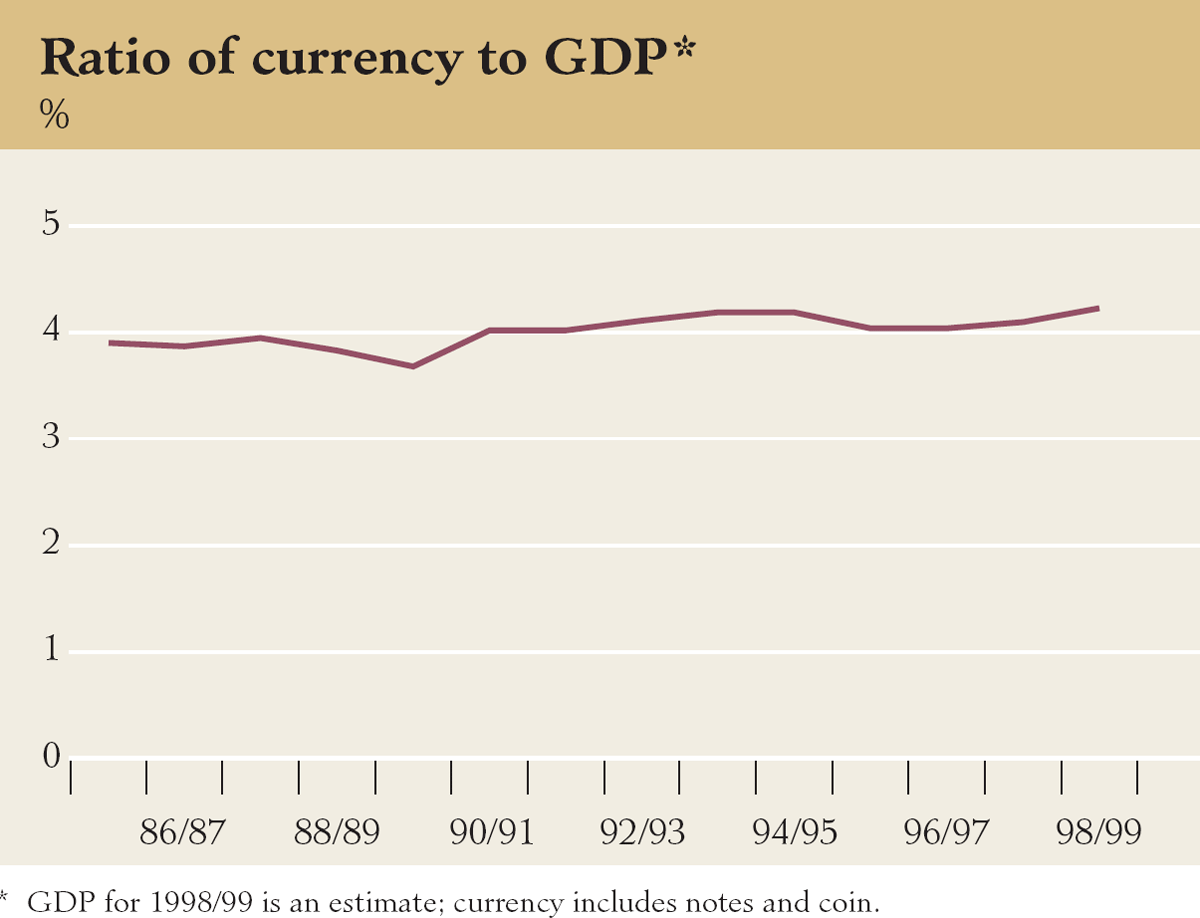
| At end June | $1(a) | $2(b) | $5 | $10 | $20 | $50 | $100 | Total | Increase (per cent) |
|---|---|---|---|---|---|---|---|---|---|
| 1994 | 21 | 69 | 313 | 634 | 1,795 | 6,837 | 7,907 | 17,577 | 7.4 |
| 1995 | 20 | 49 | 332 | 614 | 1,848 | 7,193 | 8,482 | 18,538 | 5.5 |
| 1996 | 19 | 48 | 337 | 583 | 1,868 | 7,928 | 8,399 | 19,182 | 3.5 |
| 1997 | 19 | 47 | 351 | 601 | 1,837 | 8,912 | 8,297 | 20,064 | 4.6 |
| 1998 | 19 | 47 | 361 | 617 | 1,804 | 9,523 | 9,280 | 21,651 | 7.9 |
| 1999 | 0(c) | 46 | 379 | 639 | 1,850 | 10,356 | 10,282 | 23,552 | 8.8 |
| (a) Last issued May 1984 (b) Last issued June 1988 (c) See Notes To and Forming Part of the Financial Statements, Note 1(i) |
|||||||||
From July 1998, the Reserve Bank introduced new currency distribution arrangements involving an increase in the number and geographical dispersion of holding points of Reserve Bank note stocks. Armoured car companies service the needs of their bank customers from these note pools. These new arrangements have unlocked significant productivity gains inherent in the move to polymer. Under the former arrangements, polymer notes were being processed by the Bank as frequently as paper notes, thereby negating somewhat the durability and security benefits of the move to polymer. The new distribution arrangements allow greater recycling of notes in the community from more convenient distribution points, thereby improving the efficiency of distribution arrangements.
The new arrangements have led to a reduction in the number of Bank staff and machines involved in note-processing Australia-wide. The cash services areas of the Bank have been restructured and cash-processing and distribution activities were discontinued in Canberra and Hobart in October 1998. Armoured car companies are now responsible for providing notes in those cities just as they are in other areas of the country outside the main distribution centres where the Bank has branches.
Counterfeiting activity
The level of counterfeiting of Australia's currency notes during the year was again very low. Around 1,700 low quality counterfeits were detected. The vast majority of counterfeits were paper reproductions of the paper and polymer series of notes, although a small number were on plastic substrate. The total number of counterfeits detected was down from around 2,300 in the previous year and around 4,400 in 1996/97.
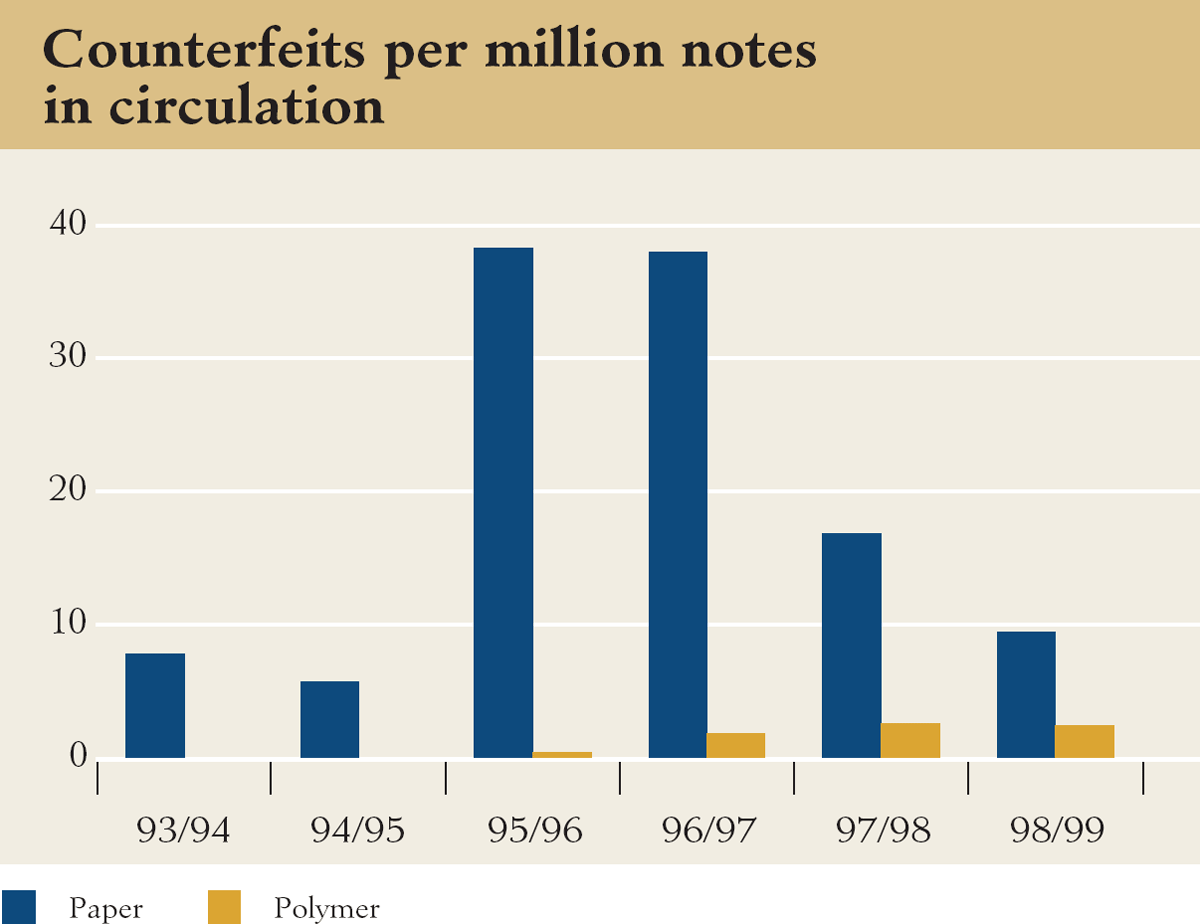
The Bank believes that the reduction in the number of counterfeits is a direct result of the use of polymer notes in Australia instead of paper notes. In particular, the move to a polymer substrate appears virtually to have stopped the casual or ‘crime of opportunity’ counterfeiter. There is, however, always a risk of counterfeiting and the Bank continues to conduct research and develop a new array of advanced features to improve even further the security of polymer notes.
New $5 note design – Centenary of Federation
Last year, the Reserve Bank announced plans to issue in early 2001 a newly designed $5 note, in conjunction with celebrations for the Centenary of Federation. The new note designed by Mr Garry Emery, one of Australia's leading graphic designers, will feature Sir Henry Parkes and Catherine Helen Spence.
The conceptual design has been completed and designers and technicians at Note Printing Australia, the subsidiary of the Bank that produces Australia's currency notes, are currently translating the conceptual design into a production prototype. This involves addressing practical printing issues, as well as incorporating security features of various types.
Appendix
| 1997/98 $ million | 1998/99 $ million | ||
|---|---|---|---|
| Revenue | – Service fees | 31.6 | 20.4 |
| – Other revenue | 4.0 | 3.0 | |
| Total | 35.6 | 23.5 | |
| Expenditure | – Direct costs | 26.3 | 12.7 |
| – Indirect costs | 6.7 | 6.2 | |
| Total | 33.0 | 18.9 | |
| Net profit/(loss) | 2.6 | 4.6 | |
| Net profit/(loss) after taxes(a) | 1.6 | 2.8 | |
| Assets(b) | – Domestic market investments | 539.7 | 587.9 |
| – Other assets | 25.6 | 23.0 | |
| Total | 565.3 | 610.9 | |
| Liabilities(b) | – Capital & reserves | 25.0 | 25.0 |
| – Deposits | 529.8 | 576.2 | |
| – Other liabilities | 10.5 | 9.7 | |
| Total | 565.3 | 610.9 | |
| (a) In accordance with competitive neutrality guidelines, income tax expense
has been calculated and transferred to the Commonwealth as a notional
part of the Bank's annual profit distribution. (b) As at 30 June |
|||
| 1997/98 $ million | 1998/99 $ million | ||
|---|---|---|---|
| Revenue | – Service fees | 4.2 | 3.8 |
| – Other revenue | 0.2 | 0.2 | |
| Total | 4.4 | 4.0 | |
| Expenditure | – Direct costs | 2.2 | 2.4 |
| – Indirect costs | 0.2 | 0.4 | |
| Total | 2.4 | 2.8 | |
| Net profit/(loss) | 2.0 | 1.2 | |
| Net profit/(loss) after taxes(a) | 1.2 | 0.7 | |
| Assets(b) | – Domestic market investments | 4.2 | 4.1 |
| – Other assets | 0.7 | 0.8 | |
| Total | 4.9 | 4.9 | |
| Liabilities(b) | – Capital & reserves | 4.0 | 4.0 |
| – Other liabilities | 0.9 | 0.9 | |
| Total | 4.9 | 4.9 | |
| (a) In accordance with competitive neutrality guidelines, income tax expense
has been calculated and transferred to the Commonwealth as a notional
part of the Bank's annual profit distribution. (b) As at 30 June |
|||
| 1997/98 $ million | 1998/99 $ million | ||
|---|---|---|---|
| Revenue | – Service fees | 3.0 | 2.6 |
| – Other revenue | 0.2 | 0.1 | |
| Total | 3.2 | 2.7 | |
| Expenditure | – Direct costs | 1.7 | 1.4 |
| – Indirect costs | 0.7 | 0.5 | |
| Total | 2.4 | 1.9 | |
| Net profit/(loss) | 0.8 | 0.8 | |
| Net profit/(loss) after taxes(a) | 0.5 | 0.5 | |
| Assets(b) | – Domestic market investments | 3.6 | 2.6 |
| – Other assets | 0.3 | 0.3 | |
| Total | 3.9 | 2.9 | |
| Liabilities(b) | – Capital & reserves | 3.0 | 2.0 |
| – Other liabilities | 0.9 | 0.9 | |
| Total | 3.9 | 2.9 | |
| (a) In accordance with competitive neutrality guidelines, income tax expense
has been calculated and transferred to the Commonwealth as a notional
part of the Bank's annual profit distribution. (b) As at 30 June |
|||